With industry-leading distribution and tens of millions of users flocking to its tap-to-earn games, TON has drawn the attention of crypto natives and normies alike. Can TON replicate this success in DeFi and finally take the sector mainstream?
The Open Network (TON) has been one of the breakout successes of 2024. The layer 1 platform has emerged from relative obscurity to occupy a central place in the crypto industry’s mindshare in a little over a year.
Its rapid rise is due in large part to the network’s relationship with Telegram. Unlike other major social media platforms, Telegram has pressed forward on integrating web3 technologies, and has chosen TON as the preferred blockchain platform to build this functionality. The relationship between the two has been a boon for TON, with several gaming applications on the platform reaching millions of users at a pace previously unseen in the crypto space.
The ability to leverage Telegram’s massive distribution puts TON in a unique spot among blockchain platforms in terms of its potential for adoption. We’ve so far only seen glimpses of this potential, with activity to date mostly concentrated in simple so-called “tap-to-earn” games that have struggled to convert explosive early interest into sustained adoption. We’re excited to see this potential actualized as the platform and its ecosystem matures. And we’re particularly interested in seeing whether TON’s distribution advantage can be leveraged to finally help DeFi expand its horizons beyond a niche crypto-native audience and into the mainstream.
Telegram is One of the Most Popular Social Media Apps Worldwide
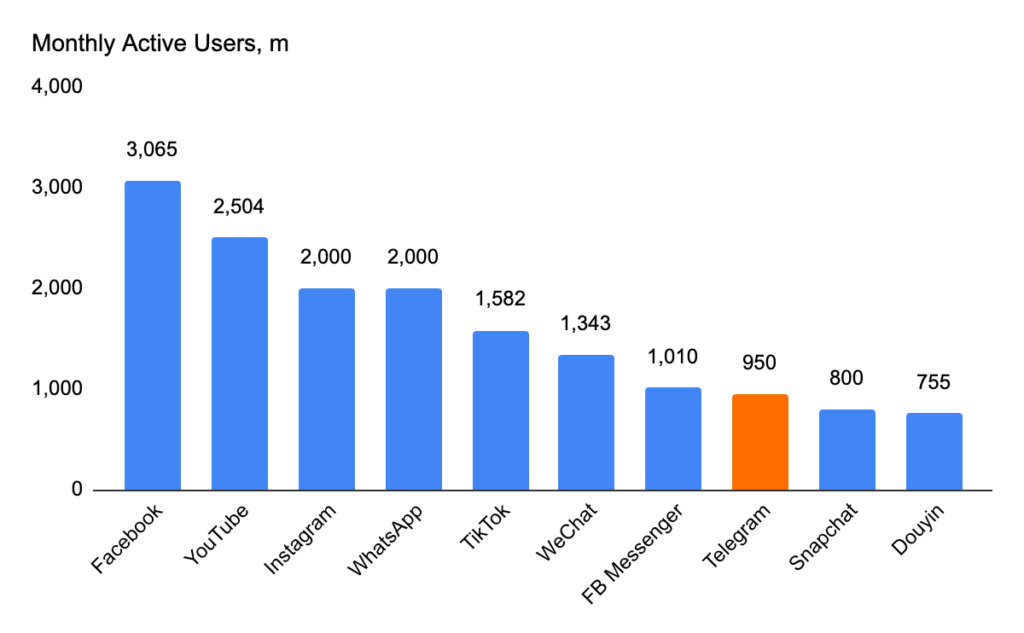
Source: Statista, Telegram, GSR.
TON’s Origins and Rise
The TON project started in 2017 as the Telegram Open Network. It was conceived amidst the ICO boom as a way of raising money for and monetizing Telegram, which had to date been self-funded by founder Pavel Durov. The Telegram Open Network was meant to complement Telegram’s chat functionality by adding native payments and other web3 services, including smart contract applications and decentralized storage. By doing so, Telegram sought to emulate the WeChat super-app model by integrating a suite of social and financial services into a single app.
TON quickly became one of the most talked about and highly-anticipated blockchain projects at the time of its announcement and raised a massive $1.7 billion over two token presale rounds in 2018. However, the project faced a major roadblock a year later in October 2019, as the SEC filed a lawsuit against Telegram alleging that the company had participated in an illegal sale of unregistered securities through its TON ICO. In June 2020, Telegram settled with the SEC, paid an $18.5 million fine, and returned the money raised to investors.
The SEC’s suit occurred just as Telegram was gearing up to launch the mainnet version of the TON network. The team had spent a couple of years developing the blockchain’s technology and had a working testnet. Given the lawsuit, however, Telegram announced they had ceased work on the TON project in May 2020 and transferred development over to the open-source community. Given Telegram’s decision to step away from the project, TON faded from the limelight right around the time that crypto gained renewed attention during DeFi summer in 2020.
Despite this, multiple open-source efforts continued developing the TON codebase. One effort in particular, NewTON led by Anatoly Makosov and Kirill Emelyanenko, emerged as a leader, and in August 2021 Telegram transferred the official ton.org domain and the official ton-blockchain GitHub repository over to them. NewTON continued to build upon the existing testnet Telegram had built, following the roadmap set in the white paper authored by Nikolai Durov. In May 2021, the testnet was considered to be stable and secure enough to be converted into the TON mainnet. At the same time, the NewTON team rebranded to the TON Foundation. By the end of 2021, Toncoin, TON’s native currency, was listed on major exchanges, setting the stage for broader adoption as the team continued to improve the network.
Despite the lack of an official affiliation with The Open Network project, Telegram reestablished a public relationship with the TON project in 2022. In October 2022, Telegram introduced the ability to auction off and buy Telegram usernames on the TON blockchain through the Fragment marketplace. In September 2023, Telegram announced it would exclusively rely on TON for its web3 features, and integrated The Open Platform’s Wallet in Telegram directly into the Telegram app. Later on, in March 2024, Telegram introduced the ability to buy ads on Telegram channels using TON’s native currency, Toncoin, with channel owners earning 50% of the revenue from ads displayed on their channel.
Efforts to integrate TON into Telegram quickly paid off in terms of driving usage of crypto applications on the TON blockchain. Notcoin, a TON mini-app-based tap-to-earn game, launched on January 1st, 2024, and reached 35 million active users by May. Similarly, fellow mini-app tap-to-earn game Hamster Kombat launched in late March 2024 and claimed to hit 300 million total players by July, with 94 million active players in August, per Telegram data.
Hamster Kombat’s Total Users Rivals the Most Downloaded Games
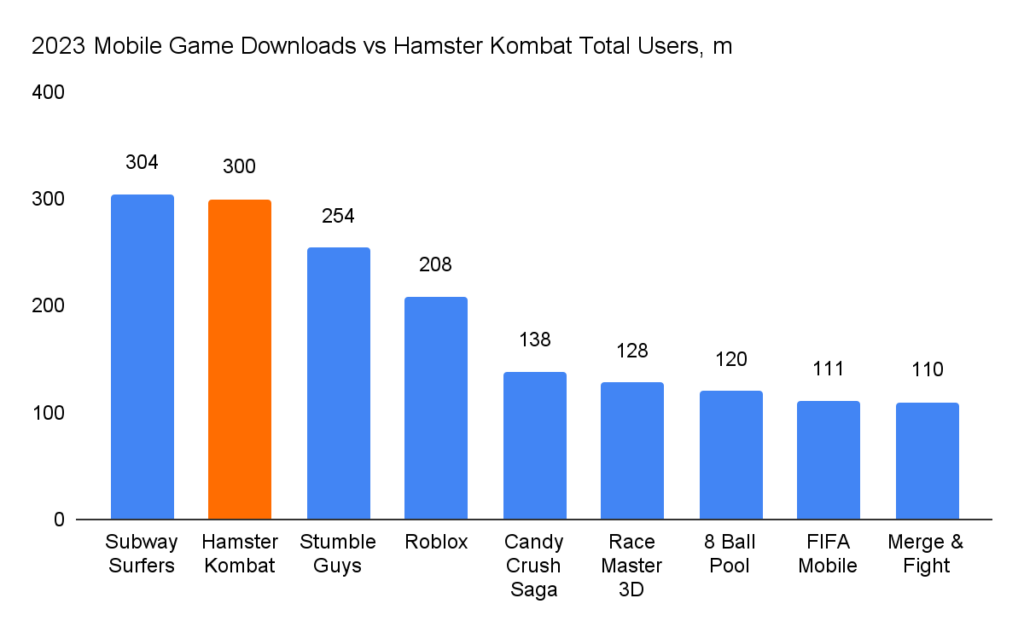
Source: Hamster Kombat Official X Account, Business of Apps, GSR.
These player counts have understandably drawn the attention of the entire crypto industry, as they are practically unprecedented in the crypto gaming space. This scale is particularly impressive when compared to other crypto applications and games, as it significantly surpasses the previous high of around 2.7 million monthly active users reached by Axie Infinity in November 2021. It also rivals player counts of popular Web2 games like Fortnite, which attracts around 100 million monthly players. Similarly, Hamster Kombat’s total player count of 300 million approximates the 304 million total number of downloads that the most popular mobile game in existence, Subway Surfers, achieved in 2023. While it’s worth highlighting that the monetary incentives of crypto games can drive substantial amounts of inorganic usage and bot activity, it remains notable that these applications on TON have far exceeded the reach of comparable crypto applications with similar incentives on other chains.
The user counts reached by tap-to-earn games on TON underscore the power of Telegram’s distribution. TON’s close integration with the messaging app puts crypto at the fingertips of 950 million Telegram users. Access to this user base has in a short time made TON one of the most used blockchains. Monthly active addresses on the network grew from around 100 thousand in September 2023 – when Telegram introduced its integrated wallet – to 9.9 million in September 2024. This puts TON ahead of Ethereum’s 5.5 million active addresses in September 2024, and ahead of popular Ethereum L2s and sidechains like Arbitrum, OP Mainnet and the Polygon PoS chain. By this metric, however, TON still lags behind chains like Base and Solana.
TON has Surpassed Ethereum and Popular L2s in Active Addresses
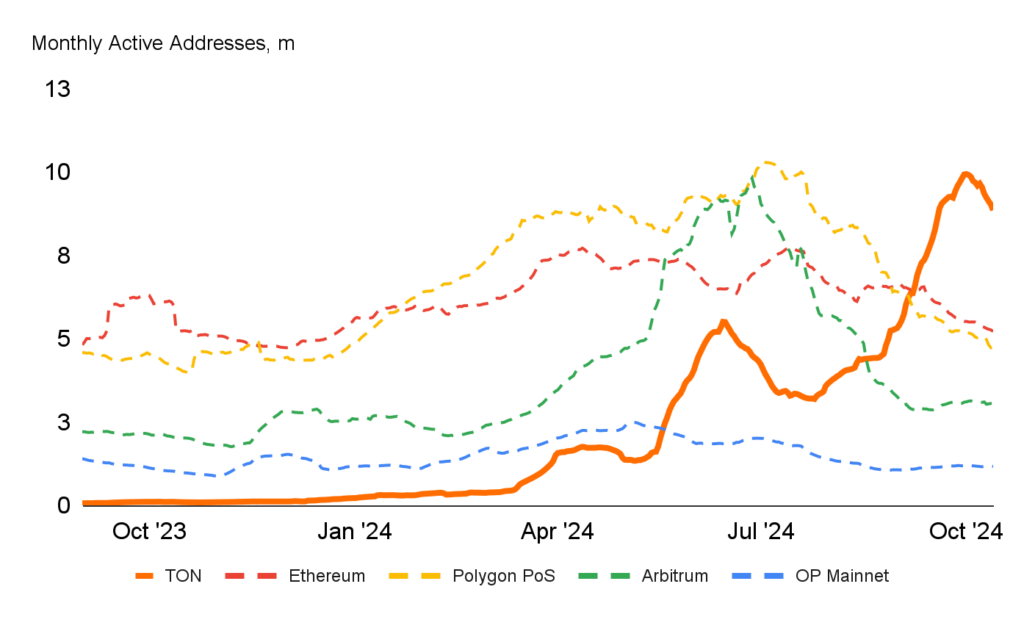
Source: Artemis, GSR.
Note: While active addresses are an imperfect measure that can be inflated by bot activity, they still provide a useful indicative benchmark.
Mini apps, User Experience, and Virality
While the success of TON apps like Notcoin and Hamster Kombat is in no small part due to the size of Telegram’s user base, the key to their growth is largely driven by how they’ve leveraged the messenger’s distinctive features to develop a simple and intuitive user experience and introduce highly viral mechanics.
A core ingredient driving the popularity of these experiences has been the use of Telegram’s mini-app functionality. Mini apps allow users to access interactive and complex web applications directly from the Telegram app by using a Telegram bot or clicking on a link without having to download a separate application. Users can play games, shop, order food, use financial applications, or do pretty much anything else developers can think of via mini apps.
With mini apps, Telegram has created an app marketplace that enables third-party developers to create their own experiences within the messenger. Developers are given a large canvas to develop web applications leveraging the most widely used and flexible web development tools like Javascript, HTML and CSS. Importantly, mini apps are able to harness Telegram’s overall functionality, such as tapping into users’ social graphs to enable social experiences, content sharing, and app invitations. Mini apps further have the ability to use Telegram’s integrated payment options, including its integration with TON. Given their ease of use and native integration with Telegram’s functionality, mini apps provide a powerful tool for developers to create compelling experiences that can immediately leverage Telegram’s network for distribution and gain access to native payments.
Combined with Telegram’s integrated TON wallet, mini apps offer seamless and approachable crypto user experiences. The integrated wallet natively operates across mini apps, allowing users to circumvent bothersome and often insecure interaction flows like importing a private key into a new embedded wallet or third-party application. Users can skip the process of having to download a separate wallet application and set up a new wallet address. The Telegram wallet works seamlessly with mini apps and only prompts interactions when needed, thus removing points of friction that detract from mini app experiences.
On top of the improved crypto user experience offered by mini apps, their integration with the messenger’s social network creates a ripe environment for viral growth to occur. From within a mini app, users can share mini app invitations and content with their Telegram contacts and groups. Coupled with rewards and incentives, this functionality allows mini apps to quickly spread through Telegram’s user base.
Games like Notcoin, Hamster Kombat, and Catizen have leveraged all of these features to good effect. Onboarding to these applications is extremely straightforward as they can be launched directly from the chat interface. Unlike many crypto apps, these games don’t require an external wallet app or browser extension, nor do they demand that a user purchases a specific token or NFT to begin the game. Within seconds of booting up the application, users can play the game and earn rewards.
These games revolve around performing simple in-game actions like tapping on your smartphone screen to increase one’s overall score. On top of in-game actions, users can accrue points by sharing invitations to the game with their contacts or groups, joining the game’s social channels and liking their social media profiles, completing quests, or even spending crypto. Given that their global game score is usually tied to an eventual token airdrop, users have a monetary incentive to perform all of these actions, which leads to these games spreading like wildfire.
With the official integration of TON into Telegram in late 2023, the stage was set for crypto apps on the blockchain to achieve viral growth. By early 2024, Notcoin adopted the now widely employed formula of using points tied to social sharing, linked with an airdrop, to reach tens of millions of users. Hamster Kombat further perfected the formula and dialed up the viral social sharing mechanics to reach hundreds of millions of users. By combining 1) the simple and intuitive user experiences of mini apps, 2) unintrusive crypto elements via the integrated TON wallet, and 3) viral mechanics, Telegram has created a mechanism for mass user onboarding with few equivalents in crypto.
Mini Apps Enable Fully Programmable Web Experiences Within Telegram
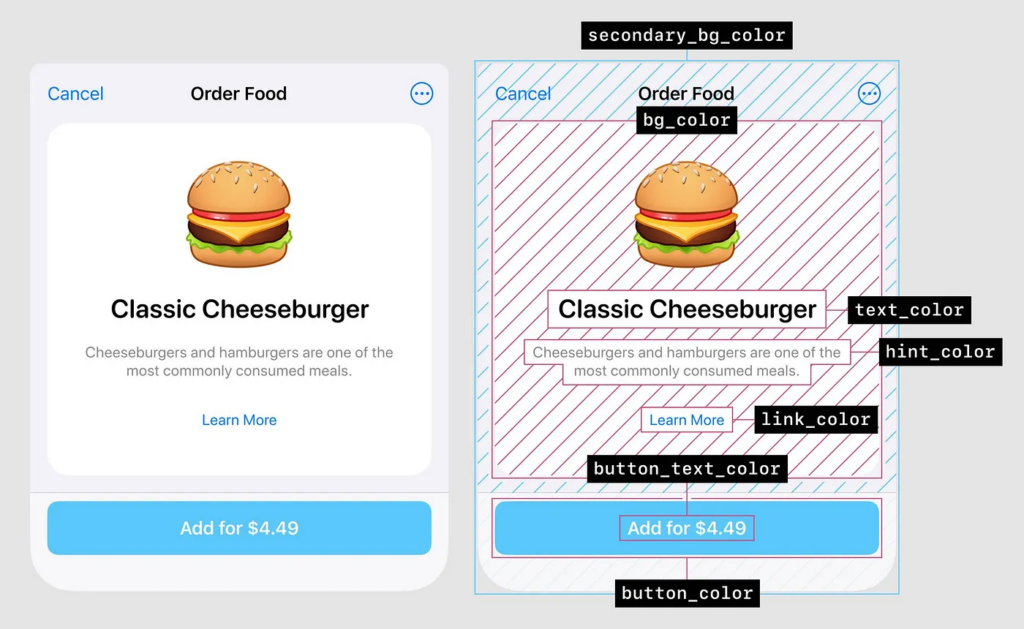
Source: Telegram Docs, GSR.
The TON DeFi Opportunity
We’re excited to see what developers can accomplish with the unique potential that the marriage of Telegram and TON offers for crypto applications. We’re interested in seeing crypto gaming and social applications that expand beyond the growth mechanics that have been used to date and build experiences that capture enduring interest.
While most of the attention around TON has focused on applications in the gaming and social segments, we believe that the TON+Telegram ecosystem also offers great potential for DeFi to finally break beyond its primarily crypto-native audience in what amounts to a massive opportunity that hasn’t received due attention.
DeFi was central to the flurry of attention that was concentrated on crypto in 2020 and 2021. It sparked the imagination of many with the promise of an automated, efficient, flexible, and secure decentralized financial system. Despite this promise, the sector has languished since then. According to data from Artemis, since the beginning of January 2022 through the end of September 2024, tokens associated with DeFi protocols are down 72% as a sector, trailing sectors like memecoins (down 35%) and smart contract platforms (down 48%), and compared to Bitcoin’s 42% rise. The optimism of 2020 and 2021 has largely given way to pessimism in DeFi.
DeFi Price Performance has Lagged Since 2022
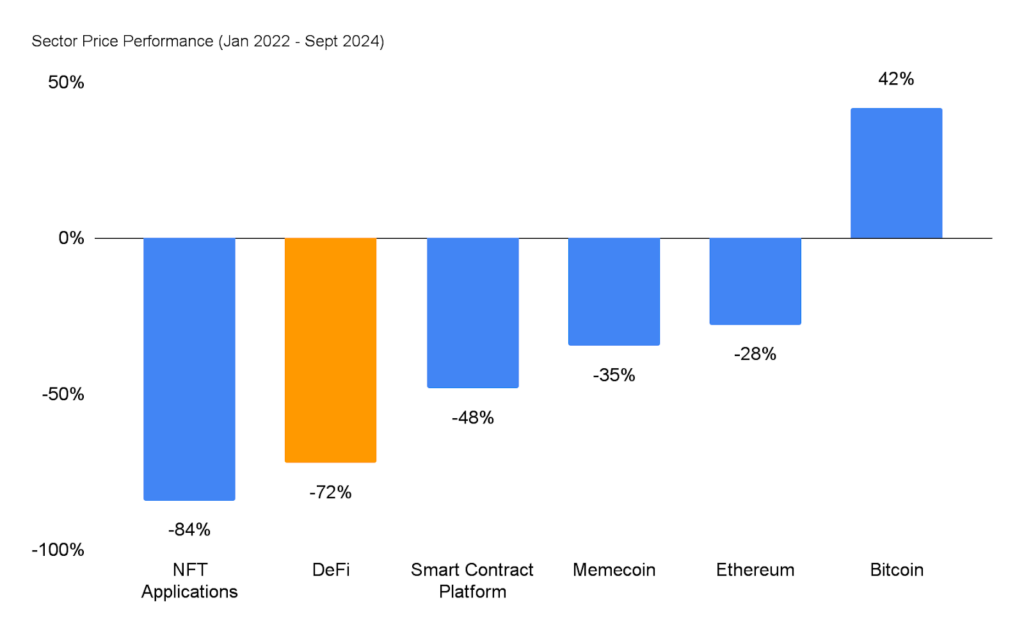
Source: Artemis, GSR.
DeFi to date has not been able to deliver on the potential that catalyzed the crypto bull market in 2020 and the lackluster price action is reflected in similarly disappointing user numbers. Per DEX user data from Dune Analytics put together by Varrock’s Richard Chen, DEXs across all of the chains that Dune tracks have on aggregate recorded at most around 22 million unique addresses in a single month, a high reached in September 2024. Under the plausible assumption that users are more likely to use multiple addresses than it is for a single address to represent multiple users, and supposing that many addresses are used by bots, we can take this figure as a rough upper bound for the number of real unique DeFi users, and can speculate that the actual number is substantially lower. Despite its global reach and permissionless nature, DeFi remains fairly niche.
There are a myriad of reasons for why DeFi has been unable to achieve higher levels of adoption, which range from problems related to blockchain scalability, security and data protection to challenges around liquidity and capital efficiency, and issues with financial regulation worldwide. Since 2021, teams across the industry have been hard at work moving the space forward, and substantial progress has been made. Despite this progress, however, broad-based adoption remains elusive.
Monthly Active Users Across DEXs Have Only Barely Exceeded 20m
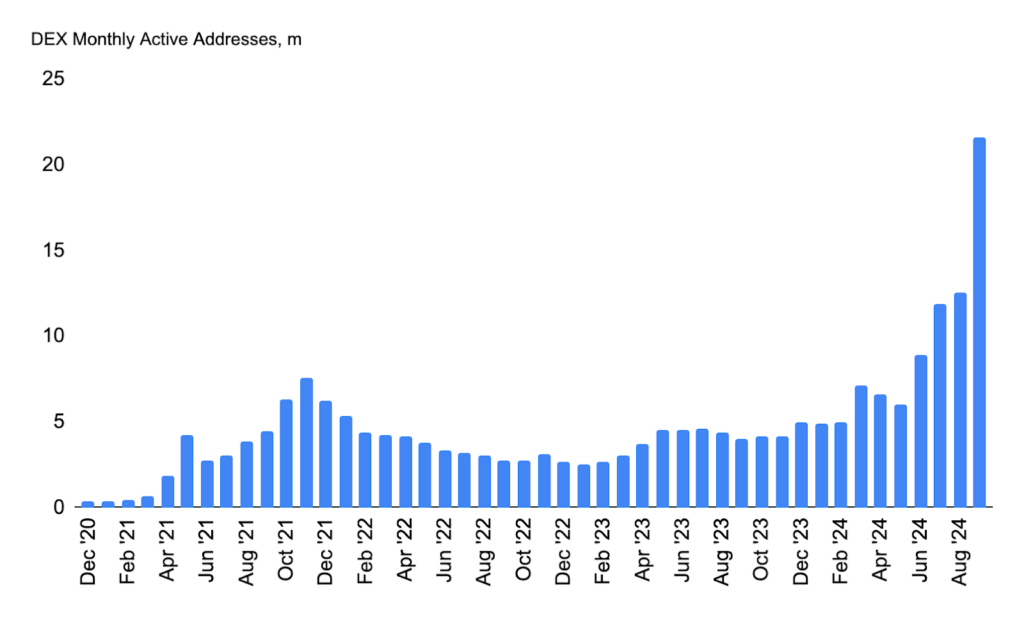
Source: Dune Analytics, @rchen8, GSR.
Among the issues that have held DeFi back from broader adoption, it’s worth highlighting the difficult user experience across DeFi apps, and the lack of strong distribution channels. To date, it’s proven difficult to onboard users by having them download unfamiliar apps/browser extensions, visit a confusing sequence of apps and/or websites, onramp via exchanges or separate services, and learn about gas payments and cross-chain bridging. The whole experience is often overwhelming. On the flip side, large web2 platforms that could directly onboard millions of users to web3 have largely either ignored web3 or abandoned related efforts, closing some of the more promising avenues for crypto apps to achieve mass distribution.
With crypto mini apps and the integrated wallet, TON and Telegram have largely solved these issues. Telegram has distribution in spades with its 950 million users, and its native integration with TON sidesteps many of the UX frictions that have plagued DeFi applications. Users don’t need to download separate wallets, or go to a different exchange to purchase assets. Telegram’s wallet includes integrations with on-ramps and a P2P marketplace, enabling the entirety of the experience to occur within a single app. Airdrops tied to games have also put tokens in the hands of a large number of Telegram users, effectively onboarding them into crypto without drawing their attention away from the games that they want to play. Few have done as good a job as Telegram at putting crypto in the hands of many and familiarizing them with the technology.
The importance of distribution for DeFi cannot be overstated. To start, there’s the simple fact that good distribution channels can help DeFi applications reach a greater number of users more easily. Beyond that, it’s essential given the network effects needed to bootstrap many types of financial applications. The utility of payment networks, for example, is closely tied to the number of users in the network since the value such networks provide depends on the ability of users to reach the parties that they want or need to pay. Similarly, network effects help improve the liquidity that is the lifeblood of trading and collateralized lending applications. They help increase counterparties, assets, and trading volumes in any one venue, thus improving price discovery and reducing slippage.
The above points to the high potential that DeFi has on TON. Through Telegram, DeFi applications on TON have a unique opportunity to reach hundreds of millions of users and businesses. This reach further creates a positive feedback loop, allowing applications to build network effects and improve liquidity, thereby greatly boosting the value they provide to users.
Capitalizing on the Opportunity
Tap-to-earn games like Notcoin and Hamster Kombat provide a rough outline for how DeFi on TON can realize its potential. Viral mechanics leveraging rewards for inviting users and contributing liquidity can be an extremely powerful bootstrapping mechanism. Such mechanics mirror the liquidity incentives DeFi protocols have employed to date. However, these types of incentives gain a whole new level of potential to drive growth in the context of a widely adopted, easy-to-use platform like Telegram. Notcoin, Hamster Kombat, and Catizen have done an impressive job of distributing their tokens across a large number of users. DeFi applications could mimic the same approach to establish a large early base of protocol users and liquidity.
Among Memecoins TON Tokens Are Some of the Most Widely Held
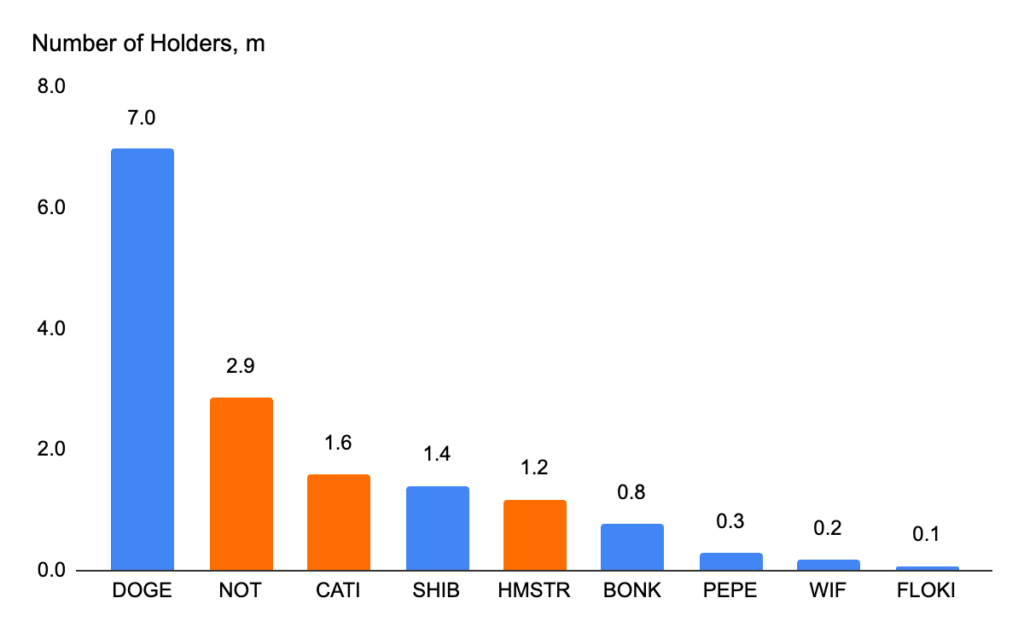
Source: Tonviewer, Etherscan, Solscan, Coincarp, GSR.
Implementing functionality in the form of mini apps likewise provides a strict upgrade in the onboarding and user experience for new DeFi users, sparing them from having to deal with a cacophony of apps, wallets, browser extensions and on/off ramps. As tap-to-earn games on TON have done, DeFi apps can delay the introduction of crypto elements upfront, allowing users to participate in fun, gamified activities or an airdrop before having to think about on-ramping fiat, safely storing a seed phrase, or purchasing a specific asset.
The ability to bootstrap a large initial set of users and liquidity makes TON a compelling platform for a multitude of financial use cases.
Payments are, we believe, a particularly compelling opportunity for TON. Telegram’s integrated wallet already enables simple peer-to-peer payments directly within Telegram chats, using the wallet’s custodial or non-custodial options. Integration with Tether’s USDT in Q2 2024 has set the stage for this use case to grow, and we look forward to seeing more assets and stablecoins also integrate with the chain. We further see the potential to build additional features on top of what Wallet in Telegram has already built, including recurring payments, bill-splitting, and payment processor/card network integrations, among others. Payments using stablecoins have been gaining traction in emerging markets due to their convenience, especially for cross-border transfers, and for the access they provide to stable currencies. Given Telegram’s popularity in emerging markets and its seamless mobile experience, we think TON is well positioned to lead in this space.
Leveraging social elements via leaderboards, competitions, copy trading, and the like is another large opportunity for DeFi unique to TON. There’s significant potential for social trading applications and DAOs to leverage Telegram groups. Such functionality could be a perfect fit for angel/venture investment communities similar to existing investment DAOs and echo.xyz. Telegram groups and communities further provide a natural environment for DeFi protocols to grow by incentivizing adoption through targeted rewards and airdrops.
Core DeFi primitives like AMMs, lending/borrowing protocols, and derivatives exchanges can likewise benefit from Telegram’s distribution to quickly gain users and liquidity. Such primitives are starting to grow on TON with the likes of Ston.Fi and DeDust on the AMM front, EVAA in lending, and Storm Trade in derivatives. However, the overall DeFi ecosystem is still somewhat immature compared to ecosystems like Ethereum, Solana, and Cosmos. TON’s DeFi ecosystem can draw inspiration from protocols in the latter ecosystems to build out more sophisticated primitives and functions including concentrated liquidity, trading pool programmability/hooks, modular lending pools, MEV protection features, order book exchanges, intent networks, and restaking, among others.
TON Currently Lags Other Major L1s in DeFi TVL and Trading Volumes
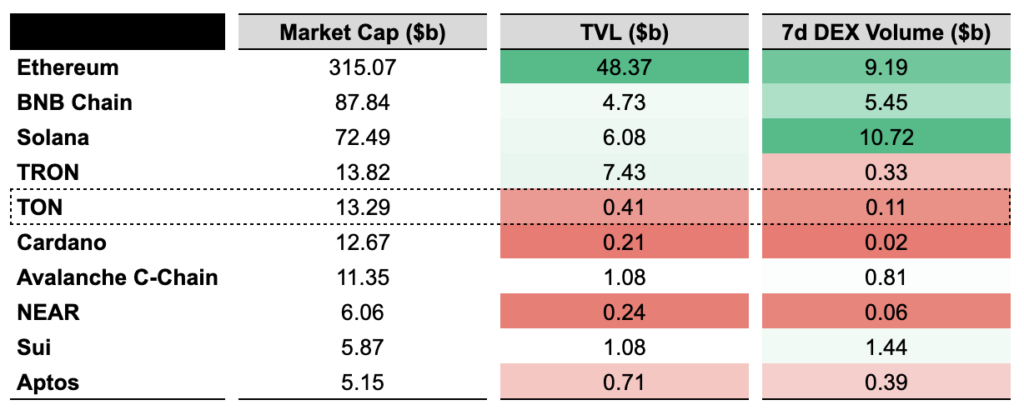
Source: CoinGecko, DeFiLlama, GSR.
Blum is an example of a Telegram-based DeFi app that is successfully following the formula set by mini app games thus far. The project aims to build a one-stop-shop for trading and launching tokens with a simplified user experience and social elements, and with integrated P2P and NFT marketplaces. As the team works to deliver on this functionality, they’ve released a teaser mini app that allows users to collect Blum points by playing a mini game, inviting friends, and completing quests. Blum points are tied to the exchange’s upcoming token airdrop, and the project has teased that they might also be taken into account for other types of rewards.
This approach to generate interest and attention has paid off. Per Telegram data, the Blum bot and mini app currently have 57 million active users. The Blum team still needs to execute on their promised functionality to turn that initial interest into continued usage, but so far they’re off to a strong start. If Blum succeeds in attracting and retaining a strong user base, it could chart a path for other DeFi applications on TON to follow.
Outstanding Challenges
While the vision for DeFi on TON is compelling, there are some challenges the ecosystem will need to confront to fully realize the vision. These challenges include:
1.) Attracting and retaining a strong developer base:
The majority of alt L1s have struggled due to their inability to attract a critical mass of developers to build compelling apps on their ecosystems. EVM-based chains have been an exception, but these have succeeded by allowing Ethereum developers to easily redeploy their EVM-based apps across multiple chains or develop applications using existing Ethereum tooling. Of the alt L1s that have chosen to implement non-EVM execution environments, only Solana has indisputably drawn a critical mass of developers committed to developing on the SVM.
Similar to Solana, TON elected to develop its own bespoke smart contract execution environment, the TON Virtual Machine (TVM). To develop on TON, developers have to master a new programming language, FunC, and familiarize themselves with the particulars of the TVM, like asynchronous messaging between smart contracts (as opposed to the EVM’s atomic cross-contract calls). Many alt L1s have struggled to attract developers to their own bespoke programming frameworks, as the incentives for developers to master a new programming stack are frequently lacking. Solana has modeled the way for how to create a highly engaged, evangelizing developer base. To succeed, TON will have to follow in its footsteps. Initiatives like the EVM-compatible TON Application Chain (TAC), a layer 2 on TON, can also offer promising avenues to grow the developer ecosystem by attracting EVM developers.
2.) Achieving scalability and maintaining uptime:
Like other blockchains, TON faces the challenge of scaling its transaction throughput to support internet-scale traffic. TON, along with NEAR, Polkadot, and MultiversX, has been one of the few remaining chains pursuing a sharding-based approach to scaling execution. Other ecosystems have gone down the path of modularizing blockchain components or vertically scaling integrated architectures with powerful hardware and engineering optimizations. Execution sharding has become less fashionable as an approach to scaling blockchains, partly due to implementation complexity, cross-shard communication overhead, loss of synchronous execution, and considerations around security in the event of shard takeover attacks. However, it remains a viable approach to scaling blockchains. TON will need to navigate these complexities to deliver on its full sharding roadmap and prevent the recurrence of blockchain outages in the face of high traffic.
3.) Ensuring Smart Contract Security:
One of the biggest challenges facing all of DeFi, not just on TON, is ensuring the safety of smart contracts which often secure hundreds of millions if not billions of dollars in value. Exploits in DeFi have been all too frequent to credibly support mainstream financial use cases, although significant progress is being made. There’s only so much core developers can do, given the task of writing safe smart contracts falls to app developers. However, entities like the TON Foundation, TON Society, or others in the ecosystem can support the creation of tooling and a smart contract auditing ecosystem around the TVM and FunC.
4.) Combating Bots and Sybils:
All of crypto confronts the challenge of dealing with artificially inflated user and transaction numbers driven by bots and sybil activity, which aim to maximize value extraction from onchain monetary incentives. We see evidence that the same issue affects TON, with some of the airdrops for tap-to-earn games showing signs of bot activity. Such activity is harmful for the establishment of a healthy DeFi ecosystem as it extracts value without providing much in return, and gives misleading signals to developers regarding where organic usage is actually occurring. TON’s integration with Telegram may provide a promising avenue to fight bot activity as Telegram accounts can be used to filter for real users. Requiring a phone number to have a Telegram account is a start, but that can be circumvented relatively easily. In the end, more effective solutions may require something like proof of humanity and/or proof of liveness technologies.
5.) Addressing Worries of Platform Risk:
One concern developers may have is whether Telegram will continue to support third-party developers on its app in the long run. Such worries are not unwarranted, as web2 platforms have in the past been known to be open and friendly to third-party developers during their early growth phases, only to become more restrictive and competitive against external developers once user growth has slowed down. In fact, one of the core promises of web3 is that it can address such platform risk through credible software commitments, decentralization, community ownership, and its open-source nature.
Telegram, however, is a web2 platform, and in the absence of decentralization in its app layer, it may need to provide assurances to third-party developers that it will not turn against them. Early indications suggest that it may be in Telegram’s interest to maintain neutrality and act instead to foster a healthy, diversified ecosystem on TON. TON has already become a highly important part of Telegram’s revenue engine and its balance sheet. In 2023, the integrated TON wallet accounted for close to 40% of Telegram’s revenues, even though the wallet was not fully integrated until September of that year. It’s well within the realm of possibility that TON-related functionality will represent the majority of Telegram’s revenue in 2024 and beyond. Telegram is thus incentivized to nurture and grow an ecosystem of third-party developers and mini apps, as the success of the ecosystem will directly impact the company’s bottom line.
If TON and Telegram can successfully navigate the challenges above, they have a strong chance to finally bring DeFi to the mainstream. TON has a unique opportunity to unlock DeFi’s potential through Telegram’s distribution. We’re very keen to see how the ecosystem evolves.
Authors:
Carlos Guzman, Research Analyst | Twitter, Telegram, LinkedIn
Toe Bautista, Research Analyst | Twitter, Telegram, LinkedIn
Brian Rudick, Senior Strategist | Twitter, Telegram, LinkedIn
This material is provided by GSR (the “Firm”) solely for informational purposes, is intended only for sophisticated, institutional investors and does not constitute an offer or commitment, a solicitation of an offer or commitment, or any advice or recommendation, to enter into or conclude any transaction (whether on the terms shown or otherwise), or to provide investment services in any state or country where such an offer or solicitation or provision would be illegal. The Firm is not and does not act as an advisor or fiduciary in providing this material. GSR is not authorised or regulated in the UK by the Financial Conduct Authority. The protections provided by the UK regulatory system will not be available to you. Specifically, information provided herein is intended for institutional persons only and is not suitable for retail persons in the United Kingdom, and no solicitation or recommendation is being made to you in regards to any products or services. This material is not a research report, and not subject to any of the independence and disclosure standards applicable to research reports prepared pursuant to FINRA or CFTC research rules. This material is not independent of the Firm’s proprietary interests, which may conflict with the interests of any counterparty of the Firm. The Firm trades instruments discussed in this material for its own account, may trade contrary to the views expressed in this material and may have positions in other related instruments.Information contained herein is based on sources considered to be reliable, but is not guaranteed to be accurate or complete. Any opinions or estimates expressed herein reflect a judgment made by the author(s) as of the date of publication, and are subject to change without notice. Trading and investing in digital assets involves significant risks including price volatility and illiquidity and may not be suitable for all investors. The Firm is not liable whatsoever for any direct or consequential loss arising from the use of this material. Copyright of this material belongs to GSR. Neither this material nor any copy thereof may be taken, reproduced or redistributed, directly or indirectly, without prior written permission of GSR.
